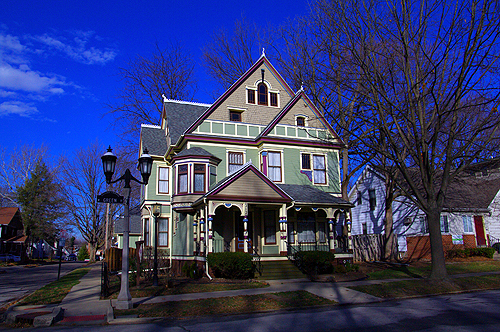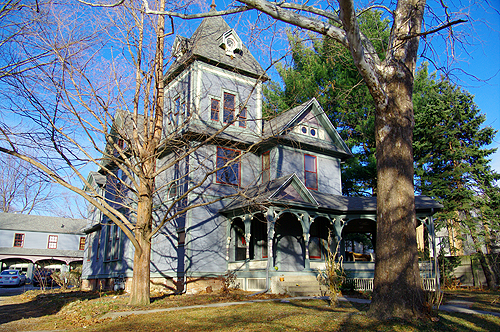Queen Anne, 1880s-1910s
 |  |
The “Queen Anne“ architectural style is a bit of a misnomer. Bearing no relation to the dominant style of Renaissance architecture in England during the reign of Queen Anne (r. 1702-1714), Queen Anne refers to a style of American architecture that was popular during the late 19th and early 20th century.
| |
The Queen Anne style draws from several architectural influences such as late medieval details from the Elizabethan and Jacobean eras. It also has several sub-types which use different styles of detailing and ornamentation. These sub-types include Spindle work, Free Classic, Half-Timbered, and Patterned Masonry. The Queen Anne style was popularized by circulating pattern books that spread throughout the country, a new architectural magazine called The American Architect and Building News, the growing network of railroads, and readily available pre-cut architectural details. The delicate spindle work and free classic versions of Queen Anne are original to America, while the half-timbered and patterned masonry sub-types were used in England before the style became popular on this side of the Atlantic.
| |
Noteworthy features of the style include asymmetrical facades, steeply pitched, irregularly-shaped roofs with dominant gables, surfaces covered in shingles, and one-story asymmetrical porches with decorative detailing. Differentiating surface materials are used as a strategy to avoid smooth-walled surfaces, giving each house a certain depth and intricacy. The most common form of Queen Anne houses are those with hipped roofs and lower cross gables. Spindle work detailing is sometimes referred to as gingerbread ornamentation or as Eastlake detailing. Eastlake detailing was named after Charles Eastlake, an English furniture designer who used similar elements seen in spindle work detailing in his work. | |
